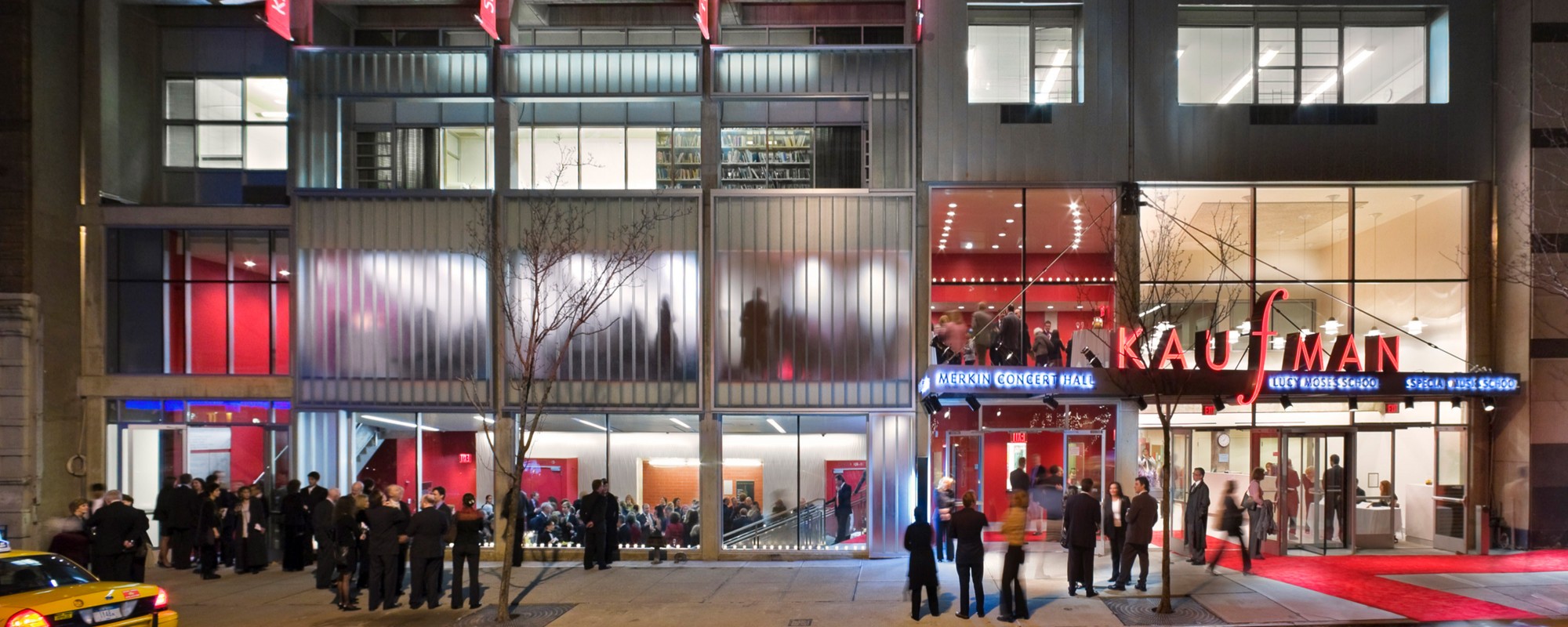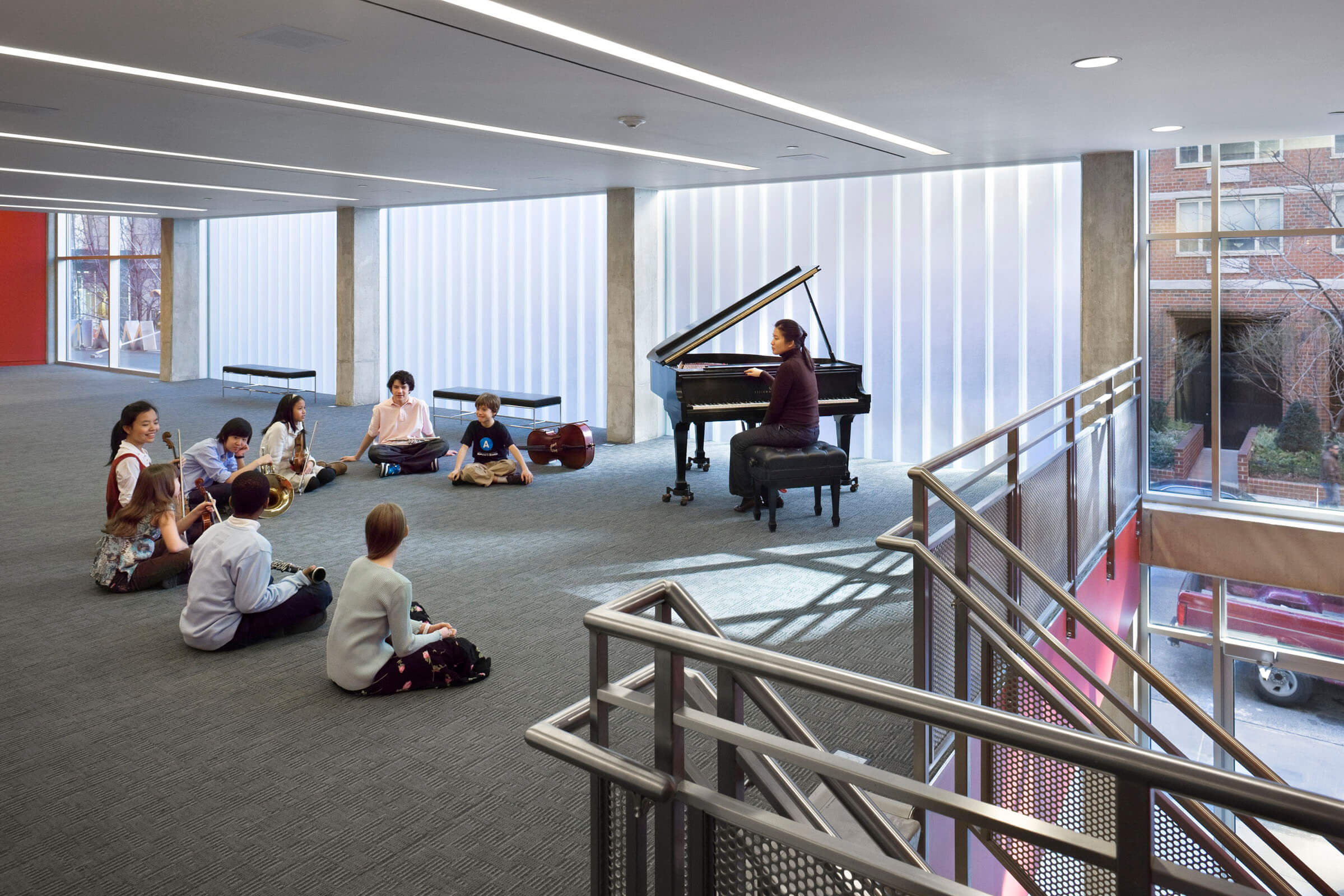
Improvements at the Kaufman Center
The Kaufman Center is a significant arts and educational institution in New York City comprised of three component parts: Merkin Concert Hall, a 650-seat performance space; the Lucy Moses School of Music; and the Special Music School, a New York City Public School for musically gifted children. The Kaufman Center is located one block from Lincoln Center in a building designed in 1978 by architects Johanson and Bhavnani, and is a significant example of the Brutalist architectural style of the period.
Our work at the Kaufman Center had three objectives: to strengthen the public image of the Kaufman Center's Abraham Goodman House with restoration and sympathetic renovation of its unique facade; to rationalize entry and circulation by enlarging the Merkin Hall lobby; and to improve the appearance and modernize the technical capabilities of the Merkin Hall auditorium while preserving its much-admired acoustical qualities. The improved Kaufman Center serves as an important cultural center and performance venue in the heart of New York far into the twenty-first century.
Our approach to the elevation that fronts 67th Street respects the compositional strength and innovations of the original building while updating and selectively replacing materials and systems to take advantage of twenty-first-century advances in lighting, signage, and material transparency. The result is a revitalized image for the Kaufman Center that engages the community and draw people to the Center's programs and events.
The reorganized entry, ticket window, and Merkin Hall lobby remedies the formerly pinched and congested concert-going experience. New materials, signage, lighting, and furnishings give the lobby a contemporary expression. A new sound lock insulates Merkin Hall acoustically from surrounding spaces, and restrooms were enlarged to meet current demands. The existing conference room makes way for a new mezzanine special events venue and an underutilized terrace was enclosed to replace the conference function.
In the Merkin Hall auditorium and its support areas, a variety of upgrades improve the concert experience for both audience and performers. New seating is complemented by improved provisions for the handicapped. Acoustically distracting systems, including air conditioning units with excessive vibration and noisy lighting control mechanisms, were modified or replaced. Hand-controlled lighting battens were replaced with motorized models, and a new control room provides updated sound and audiovisual systems. The concert hall was cleaned and restored, and back-stage facilities, including dressing rooms and storage areas, were improved.
Our work at the Kaufman Center had three objectives: to strengthen the public image of the Kaufman Center's Abraham Goodman House with restoration and sympathetic renovation of its unique facade; to rationalize entry and circulation by enlarging the Merkin Hall lobby; and to improve the appearance and modernize the technical capabilities of the Merkin Hall auditorium while preserving its much-admired acoustical qualities. The improved Kaufman Center serves as an important cultural center and performance venue in the heart of New York far into the twenty-first century.
Our approach to the elevation that fronts 67th Street respects the compositional strength and innovations of the original building while updating and selectively replacing materials and systems to take advantage of twenty-first-century advances in lighting, signage, and material transparency. The result is a revitalized image for the Kaufman Center that engages the community and draw people to the Center's programs and events.
The reorganized entry, ticket window, and Merkin Hall lobby remedies the formerly pinched and congested concert-going experience. New materials, signage, lighting, and furnishings give the lobby a contemporary expression. A new sound lock insulates Merkin Hall acoustically from surrounding spaces, and restrooms were enlarged to meet current demands. The existing conference room makes way for a new mezzanine special events venue and an underutilized terrace was enclosed to replace the conference function.
In the Merkin Hall auditorium and its support areas, a variety of upgrades improve the concert experience for both audience and performers. New seating is complemented by improved provisions for the handicapped. Acoustically distracting systems, including air conditioning units with excessive vibration and noisy lighting control mechanisms, were modified or replaced. Hand-controlled lighting battens were replaced with motorized models, and a new control room provides updated sound and audiovisual systems. The concert hall was cleaned and restored, and back-stage facilities, including dressing rooms and storage areas, were improved.






